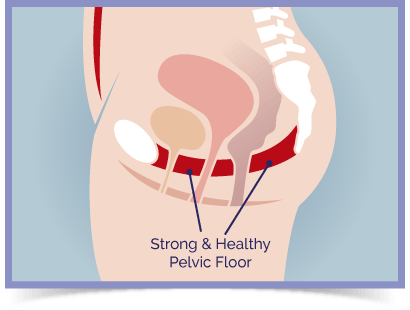
Approximately 10% of women between 20 and 39 suffer from at least one pelvic floor disorder. By keeping the pelvic floor strong, Kegel exercises help prevent pelvic floor disorders occurring and existing conditions from worsening throughout your pregnancy.
Why Do You Need To Strengthen Your Pelvic Floor Before and During Pregnancy?
Your pelvic floor is made up of muscles, ligaments, and tissues, that stretch from the base of your spine to your pubic bone. It's main role within the body is to support the function of your bladder, bowel, and uterus. This is made more difficult during pregnancy as the muscles are under extra stress from the weight of your growing baby. During pregnancy, the muscles can become exhausted and weaken, which can lead to a pelvic floor disorder.
Pelvic floor muscles are also important for:
- Sexual function - In women, the squeezing of the pelvic floor muscles is responsible for sexual sensation and arousal.
- Posture and support - The pelvic floor muscles help to support and stabilise the spine, alongside the core muscles of the abdomen and back.
-
Continence - The muscles support the function of the bladder and bowel. Weakened pelvic muscles can allow your bladder and rectum to drop and prolapse (bulge) into the vagina. This can cause urinary and sometimes faecal incontinence where you lose control of these functions.
- Bowel movement - Constipation can occur when your rectum or small bowel (small intestine) loses its support from the pelvic floor muscles.
How Can You Strengthen Your Pelvic Floor?
Kegel exercises are the main method for strengthening your pelvic floor during pregnancy. Completing these pelvic floor exercises regularly will act as a preventative measure towards pelvic floor disorders that can arise in later pregnancy, as well as treating any existing weak areas.
You can use an electronic pelvic toner before pregnancy to strengthen your pelvic floor to hold the weight of your baby, and after childbirth to repair any damage or pelvic floor disorders such as incontinence or prolapse.
When Can't You Use An Electronic Pelvic Toner?
You must not use an electronic pelvic floor toner if:
- You are pregnant - You can use it before pregnancy to build your pelvic floor strength for pregnancy, and after to repair any pelvic floor damage.
- You have a pacemaker - It can be possible to use a Kegel8 electronic toner with specific pacemakers, but check with your healthcare provider first.
- You have a form of pelvic cancer - Unless advised to do so under medical supervision, you cannot use an electronic pelvic toner if you have a form of pelvic cancer. Instead, try the Kegel8 Vaginal Cones to help you work out your pelvic floor muscles correctly and efficiently.
- You have had recent pelvic surgery (less than 12 weeks ago).
- You have epilepsy.
- There is any infection or tissue damage.
To learn more about safely exercising your pelvic floor during pregnancy, visit Safe Pelvic Floor Exercises During Pregnancy.
Sources
DeLancey, J.O., Morgan, D.M., Fenner, D.E., et al. (2007). Comparison of levator ani muscle defects and function in women with and without pelvic organ prolapse. Obstetrics and Gynecology. 109, pp. 295-302.
Hoyte, L., Schierlitz, L., Zou, K., Flesh, G., Fielding, J.R. (2001). Two- and three-dimensional MRI comparison of levator ani structure, volume, and integrity in women with stress incontinence and prolapse. American Journal of Obstetrics and Gynecology. 185(1), pp. 11-19.
Nygaard, I., Barber, M.D., Burgio, K.L., Kenton, K., Meikle, S., Schaffer, J., et al. (2008) Prevalence of Symptomatic Pelvic Floor Disorders in US Women. Journal of the American Medical Association. 300, pp. 1311-1316.
Staer-Jensen, J. et al. (2013). Ultrasonographic Evaluation of Pelvic Organ Support During Pregnancy. Obstetrics & Gynaecology. 122(2), pp. 329-336.
University of Chicago Medicine (2018) Frequently Asked Questions About Pelvic Floor Disorders [online]. The University of Chicago Medical Center [viewed 09/08/2018]. Available from http://www.uchospitals.edu/specialties/pelvic/faq/pelvic-floor-disorders.html.



